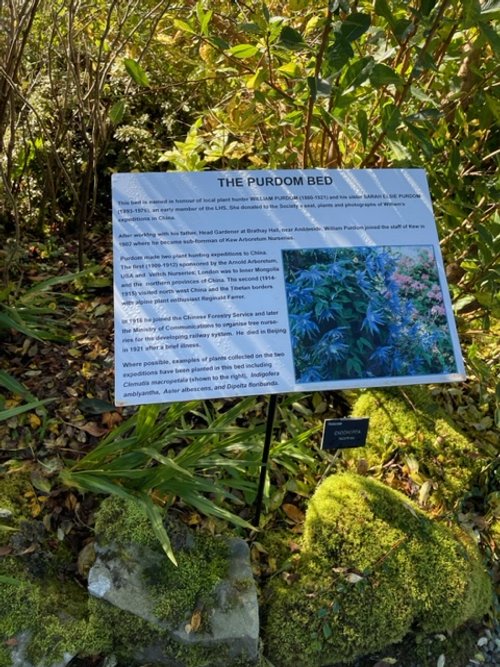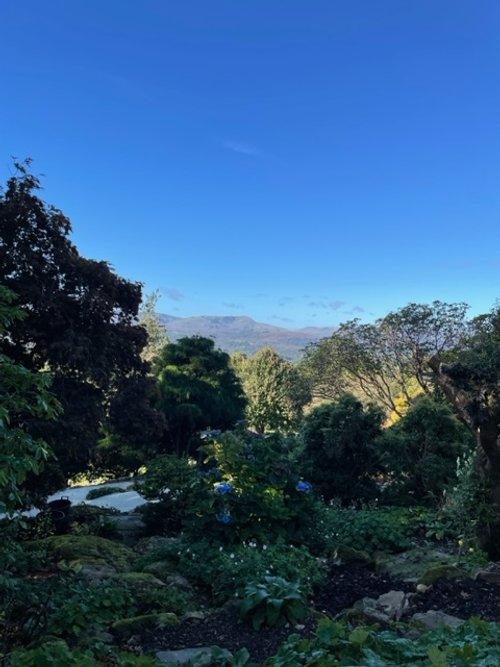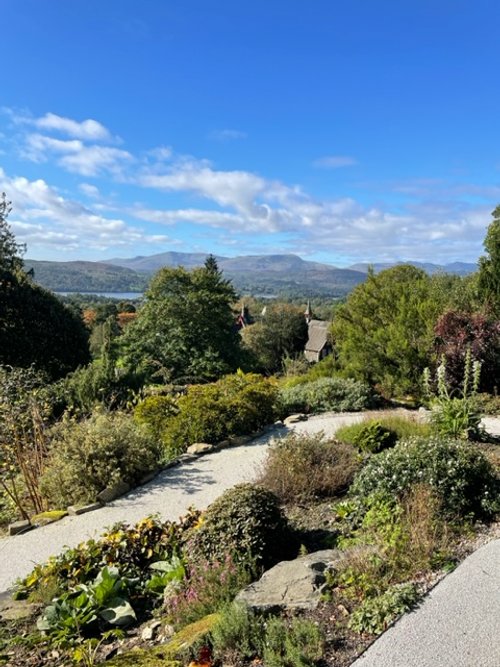Series 2 Ep 2 Viburnum Offshoot
The Purdom bench.
"What is a Purdom?” By Vicky Aspin’s own admission this was her first reaction to being sent to the Purdom bed in Holehird gardens. Then her curiosity was aroused by a name plaque on a bench: For Three Native Lakeland Gardeners, William Purdom and sons William and Harry and from that her hunt began...who was William Purdom?
Her searches before the era of the internet, first led her to write a book: A Perfect Friend - the life of a Cumbrian Plant Hunter William Purdom by O.V. Presant. They then led her to China and the Purdom Memorial Forest Park and you can hear the story of her search and Purdom's life in this Offshoot episode recorded on a sunny Autumn day, sitting on the Purdom bench in Holehird Gardens in Cumbria.
If you want to hear more about Purdom’s connections to Cumbria and specifically the Hough family at White Craggs do listen to the Plant Story: Penn’s Viburnum. You can also read Penn Allen’s fascinating book based on the diaries of her Great Grandmother Alice Hough. The Lost Garden of Loughrigg is a story of love and loss and a garden built with hard work and firm friendship.
The link to both episodes is Viburnum farreri and William Purdom who bought the plant back from his first trip to China and it was propagated and grown at White Craggs in the garden of his close friend Dr Harry Hough. It now grows in Holehird Gardens which are looked after by the volunteers, like Vicky and Alan Oatway, of the Lakeland Horticultural society. However the name of the plant relates to Purdom’s second expedition to China in the company of Reginald Farrer.
Why is it called Viburnum farreri?
Vicky: ‘The Viburnum is now known as Viburnum farreri which I think is a total mis-justice. Simply because I think botanically it's the way things go. But Purdom collected two Viburnum when he was out on his first expedition to China. 689 and 690 I think they were and he bought them back and they were propagated… it grew beautifully, flowered but the source of the propagation material was from a monastery garden therefore it was not collected in the wild. And so when he traveled out with Farrer he said, yes, I will find you Viburnum fragrans growing in the wild, which he did. And it came back and it grew and was propagated. And at some stage, it was decided that as Farrer had bought back the propagation material or sent back the propagation it would be right and proper to call it Farreri as opposed to Purdom though he was the man that showed him where to get it.’
William Purdom - photo courtesy of the Lakeland Horticultural Society
Who was William Purdom?
Vicky: “He was son of a local gardener, Brathay Hall, and if we look from the seats where we're sitting we can look across Windermere in a direct line to Brathay Hall, and that's why this seat is here…. his father, well his mother and father were remarkable people, had nothing, seven children and they wanted to give them the best start in life they could. And well there we go that's when it started he was educated at Kew, became a bit of a firebrand, stood up for the working man, for the students, for what he felt was unfair treatment and... they needed to do something exciting with him without being appearing unreasonable. He had been sacked at one point and reinstated….there's an expedition we're planning, how would you like to go to China, William? Sighs of relief! In China, he won't be able to be a problem anymore. We're talking 1908. You need to remember that to progress in horticulture, you should be employed in one of the great gardens. Who's going to take on a firebrand? Nobody and yet they speak of him as an exceptional propagator, you know, a fine young man with such potential and the thought was well there was a joint expedition between the Arnold Arboretum in Massachusetts and Veitch Nurseries in London to go out and find hardy plants, mainly trees and shrubs for the Arnold Arboretum and decorative plants for Veitchs. And they needed somebody who would be cheaper to send than Ernest Wilson, the great Ernest Wilson, more amenable than George Forrest, who was brilliant, but wouldn't stand any nonsense. And in a way, I think, Purdom was a bit of an innocent.”
What did he take with him?
Vicky: “If you look at any of the expeditionary lists they're fascinating, you know one hand axe, five balls of string, you know down to the finest detail, pressing paper, you know things to make herbarium samples out of, food, shotguns, boots, clothing, waterproofs, no such thing as waterproofs as such, how did you keep dry - you know, a good tweed jacket, a knitted jumper, and you know where they were sending him was not a well-known area…. there were no maps, very few maps, because he was going into unmapped territory for …three years do not come back within that time. In the first six months you will go to ABC, you will make lists of plants, you will note where they are, you will see if they're flowering, you will then in the autumn return to exactly the same places and collect the seed, if you can find it, you will then dry the seeds, you will pack it, you will send it to us in packages of XYZ. And while you're doing that, you will take photographs, you will make herbarium samples, you will take detailed records of the local people, the topography, etc, etc. Oh, and by the way, it'll probably be helpful if you learn to speak Chinese.”
How Long was the second Expedition with Reginald Farrer
Vicky: “Well Farrer told Professor Balfour in Edinburgh that he'd do it in a year. And Professor Balfour in Edinburgh said, I think not, and you need a China hand and the only person that could possibly undertake this journey would be Purdom. And so Purdom bit his hand off but did also say, made it clear, that he was going out to help, but that if the opportunities in forestry came up, then he would not stay with Farrer…. but then who was expecting the First World War? They set out, I think March 1913 from Beijing. And by the time they got somewhere of use, First World War had started. And they found out, you know, by telegraph or whatever, through the missionaries that there was a war, over by Christmas, was it worth coming back? And could they get back even if they wanted to? Farrer then did this remarkable thing of travelling back on the Trans-Siberian Railway to Petrograd to see the herbarium samples there. 1917, Petrograd, hello! You know, revolution? Oh well, stand back, I want to look at some herbarium samples. He was indestructible, I mean, he was extraordinary. And Purdom stayed behind, packed all the seeds and plants, was offered a job with the railway, you know, forestry commission and so forth, stayed and died. Farrer died in 1920 in Burma and Purdom died in 1921 in Beijing. Young men born in the same year with such wonderful gifts.”
Why was Purdom ahead of his time?
Vicky: “He'd seen that when trees were cut down in quantity the climate changed, the soils dried out, the loss of bird cover and then higher mammals. And so basically the whole eco-structure went from losing the trees. And that was what he was convinced about. He wrote a report, I don't know where it went. And one of the reasons he stayed in China was he was commissioned to set up nurseries for trees that would be suitable for building the railways, you know, the taxodium types of things. And the Chinese loved him and in the Purdom Forest Park, you still see great taxodium standing in the water. and I think the park opened in what 1996, 97. It's named after him in his honour. He is known better in China than he is in his own land. They never forgot him.”
This Plant Story began with Penn Allen’s plant memory and I love that this Viburnum brought to the UK by William Purdom, now grows in her garden and is currently, as I write in January 2024, in bloom and apparently smelling wonderful - if only we could share that too.
In one of my earliest memories, on a bright frosty day, I am helping my mother to pick flowers from the garden. ‘What is that lovely smell?’ I ask, as we pause beside a huge shrub in full flower. “That,’ replied my mother, ‘is a Viburnum fragrans.’ For most of my life, I have carried with me an understanding that this exceptional plant had some unique, personal connection with my family that I did not fully understand.
Since I first put pen to paper, I have felt with all my heart that the story is too important to be lost and that though the house and garden no longer exist as they did then and the people have long since departed, the mark they made upon the landscape should not be forgotten.”
Since researching this story I have come across one further book that has been written about Will Purdom, published in 2021 by Francois Gordon: Will Purdom Agitator, plant-hunter, forester. So if these two episodes have left you wanting to read more there are 3 books for you to enjoy.








